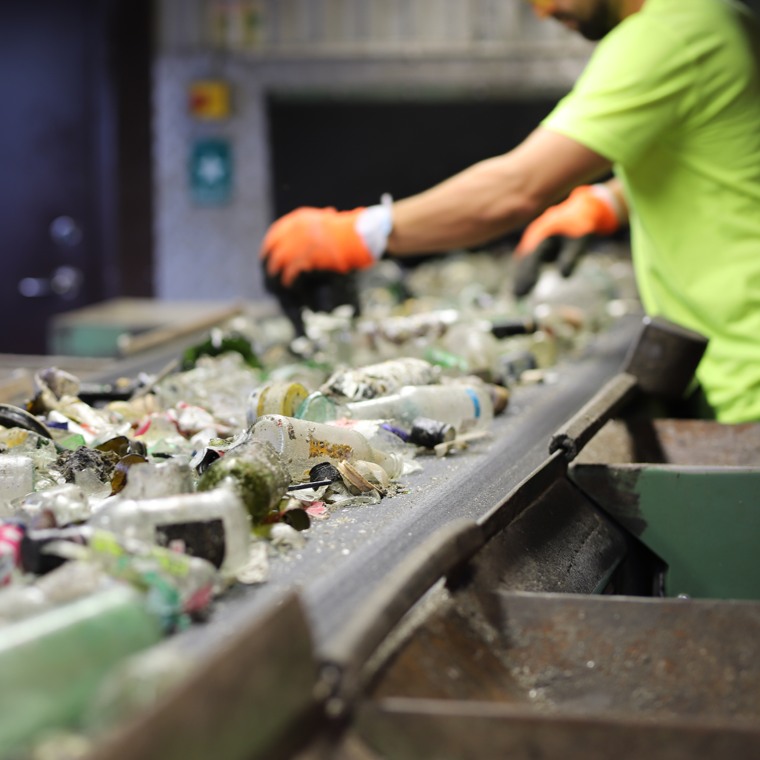Återvinning
What happens to household packaging after it has been collected, what affects recycling and what can you as a producer do to ensure that more packaging is recycled?

The steps in the recycling process
Join us for a simple overview of how the recycling process for household packaging looks like in NPA, from producer to new packaging.
In brief
How we take care of collected packaging
The packaging waste from households is treated at the sorting and recycling facilities we cooperate with. Our ambition for the packaging we are responsible for is for it to be recycled as much as possible. We therefore reward circular material recycling over linear. If circular material recycling is not possible, however, linear material recycling is preferable to energy extraction.
As a producer, do you want to know more about how the recycling process works for a certain type of material?

Swedish Plastic Recycling
When you are affiliated to us, your plastic packaging gets the chance to be recycled at their new sorting facility Site Zero – the world’s largest and most advanced plastic recycling facility.
With Site Zero, Swedish Plastic Recycling doubles its capacity and triples the number of plastic types it can receive, sort and recycle.
In this way, we create the conditions to recycle all of our producers’ plastic packaging and create circular plastic flows.

Swedish Glass Recycling
The glass packaging we collect from municipalities is delivered to Swedish Glass Recycling in Hammar. They currently recycle over 90 percent of all glass packaging in Sweden.
Every weekday, Swedish Glass Recycling receives 900 tons of glass packaging, which they sort, crush and process into a new raw material.
Glass can be recycled over and over again and become new wine bottles and jam jars.

Advanced sorting results in lower climate impact
Sorting matters
In a study, the IVL Swedish Environmental Institute, together with TERRA and Svensk Plaståtervinning, has examined the climate impact of three different ways of recycling plastic packaging.
The results show that energy recovery (without sorting and material recycling) has the greatest climate impact, closely followed by low-quality recycling. High-quality material recycling through advanced sorting, on the other hand, has a significantly lower climate impact.
The better the sorting, the more times the material can be recycled. At Site Zero, plastic packaging is sorted into twelve different fractions.

Material recycling
statistics
The material recycling rate shows how much of the packaging that producers have put on the Swedish market has been material recycled and become new, recycled raw material. The Swedish Environmental Protection Agency is the authority responsible for national statistics for material recycling of packaging.
Starting in 2024, Näringslivets Producentansvar is responsible for annually reporting information to the Swedish Environmental Protection Agency that forms the basis for the authority’s calculations of the recycling rate for various packaging materials in Sweden.
Examples of information that is reported to the Swedish Environmental Protection Agency for this are:
- What volumes of different packaging materials our affiliated producers put on the market during the year.
- What volumes of different packaging materials we collected and handled from each municipality during the year.
- What volumes of different packaging materials that have been taken care of through material recycling, energy extraction or otherwise recycled or disposed of.
- If collected packaging has been processed in Sweden or abroad.
Factors affecting material recycling
The packaging waste we receive is transported on to our procured partners and suppliers, who are responsible for the packaging material being recycled as far as possible. There are several factors that affect the material recycling rate, i.e. how large a percentage of what producers put on the market is recycled.
Everyone needs to contribute to increase material recycling
In order to meet the regulation’s requirements for increased material recycling, it is required that all parties in a packaging’s life cycle fulfill their responsibilities.
Näringslivets Producentansvar
NPA works to achieve Sweden’s goals for material recycling through collaboration with selected suppliers for sorting and recycling the collected material, and through support and advice to our affiliated producers regarding design for recycling.
Producer
In order to increase the material recycling of packaging, it is important that the producer ensures from the outset that their packaging is designed to be material recycled to the greatest extent possible. Feel free to contact our material specialists and use our packaging manuals.
Make it easier for the consumer to sort the packaging correctly, by marking them with the national sorting symbols that are also found on recycling bins.
Contact our material specialists
Read more about labeling and download the pictograms
Consumer
When the packaging has played its role, the consumer has an obligation to sort and return their packaging for recycling. Packaging that is not source-sorted never gets the chance to be recycled.
More people must sort more to bring Sweden closer to the material recycling targets for packaging.
On the sopor.nu site there is information and a sorting guide that consumers can use for questions about source sorting of packaging and other waste.
Municipality
From 1 January 2024, Sweden’s municipalities have the collection responsibility for household packaging. The material quality of the collected packaging is an important factor for material recycling.
The municipalities also have an information responsibility, which means that they must provide information to the residents about why it is important to sort their packaging and how to do it correctly.